Spontaneous intracranial hypotension
Images
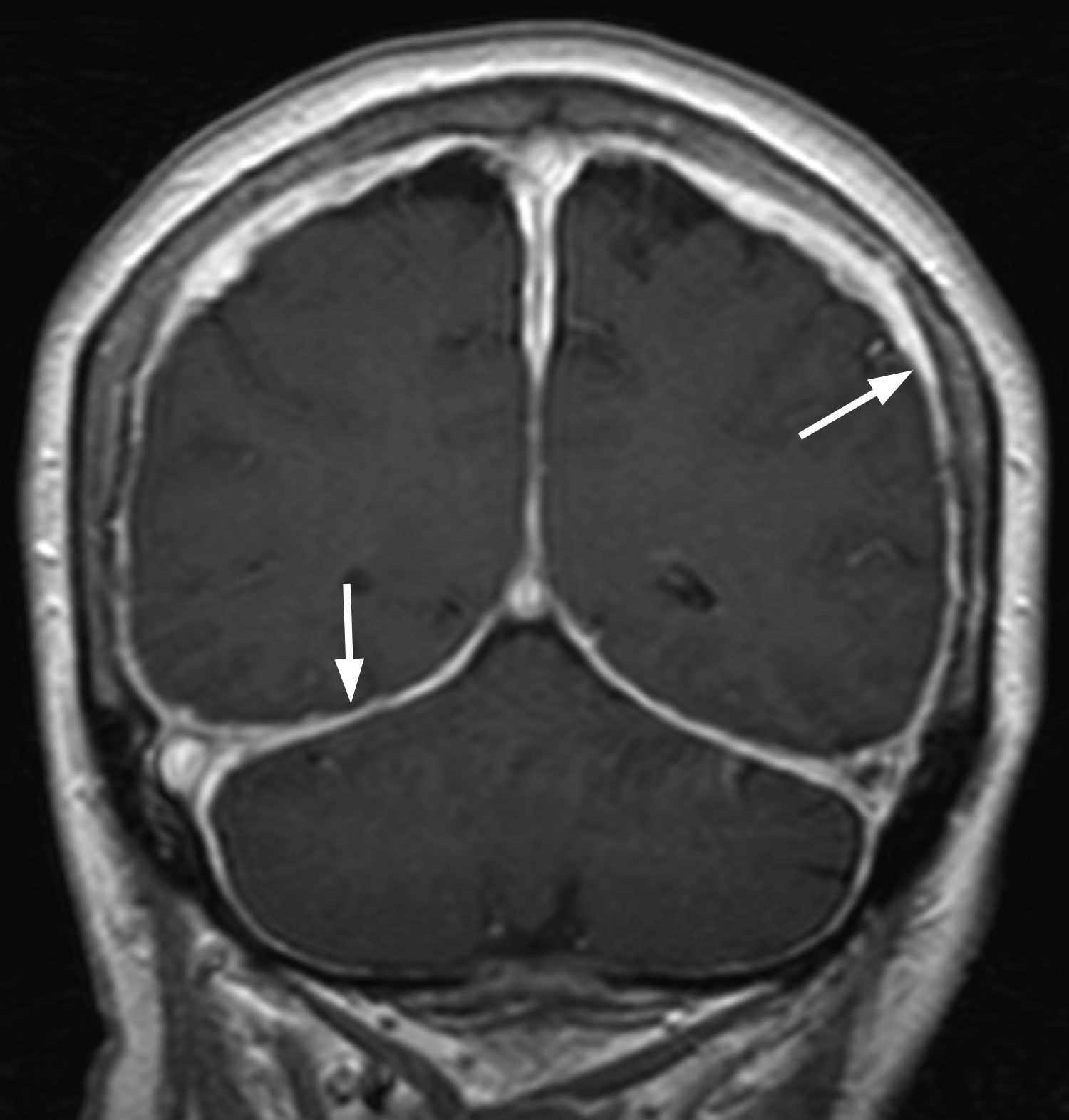




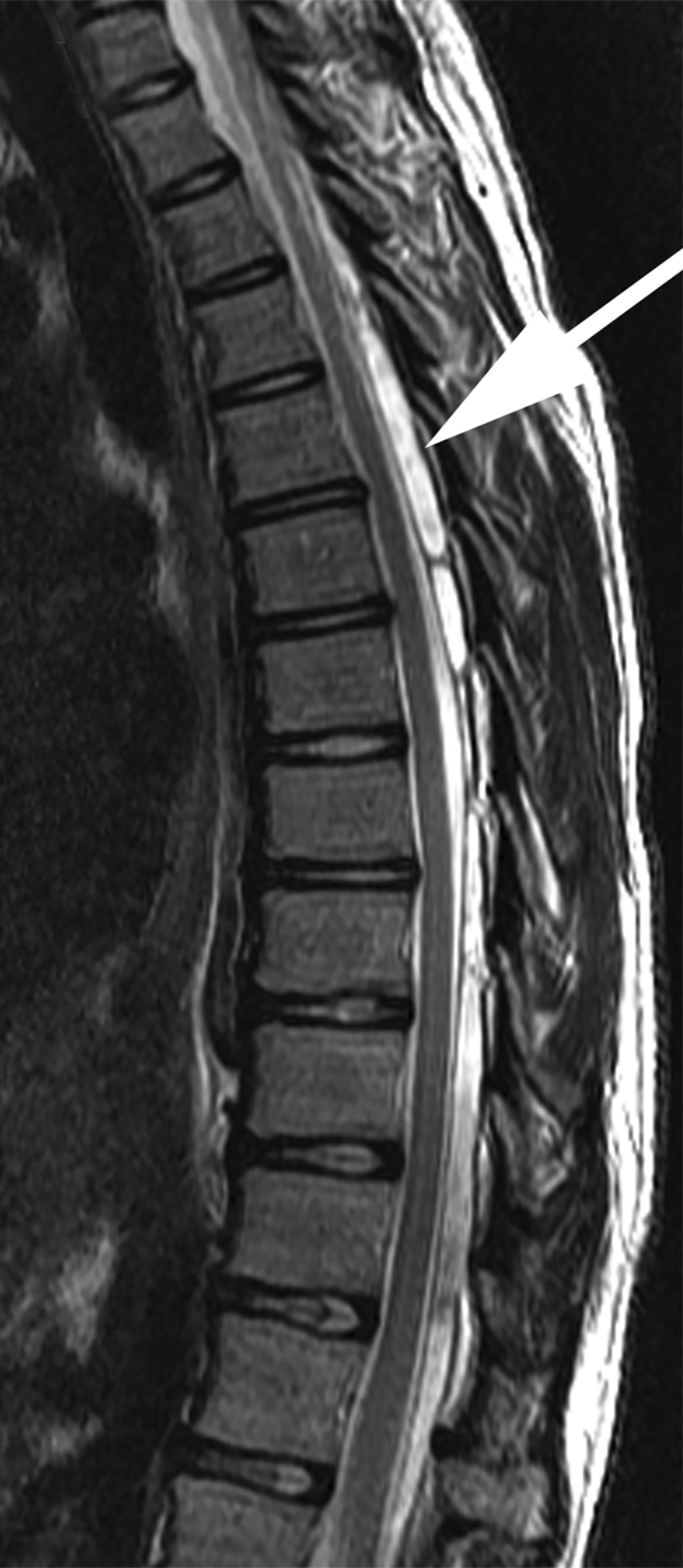
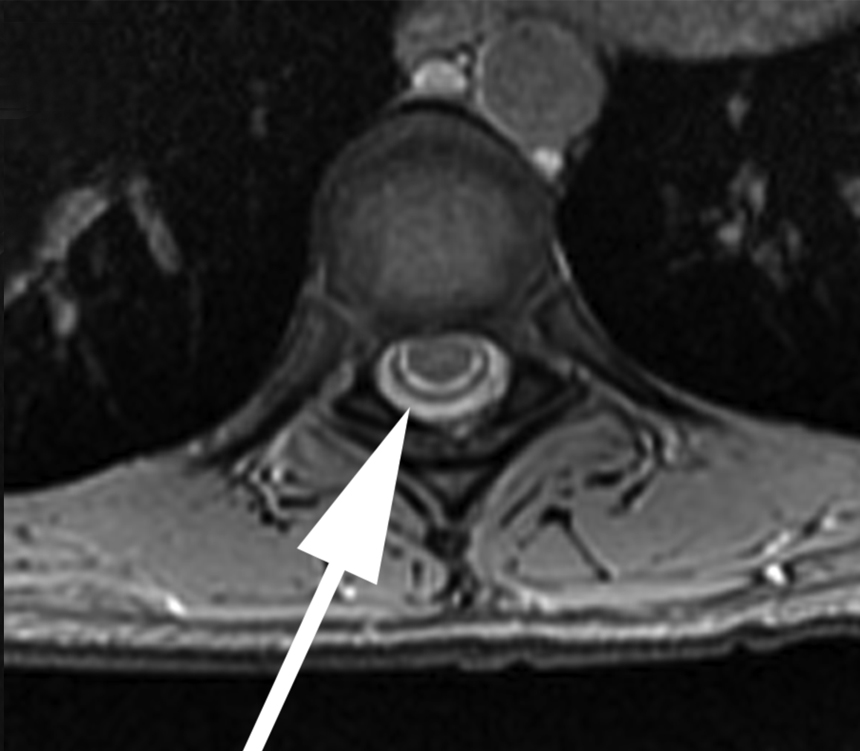
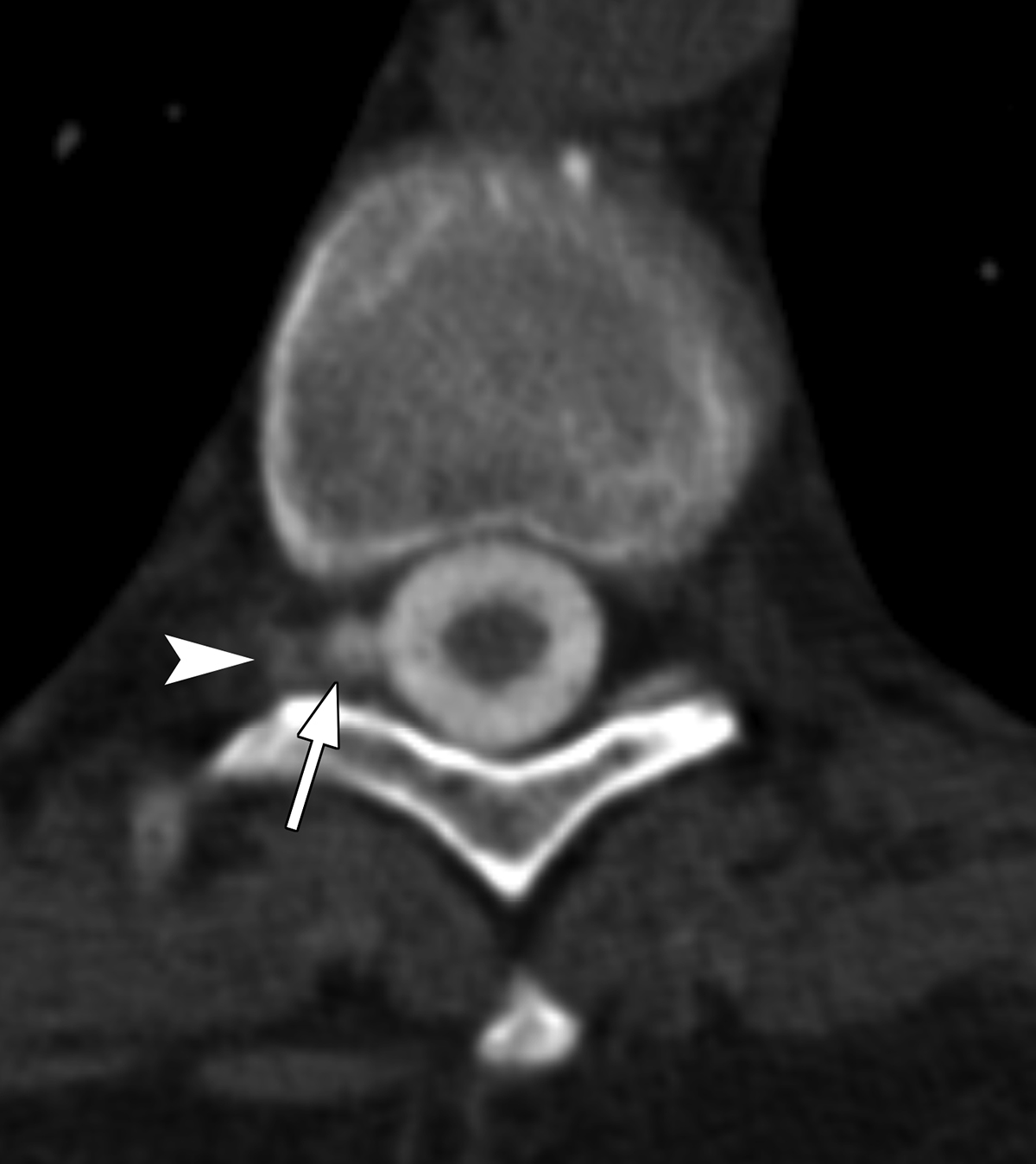
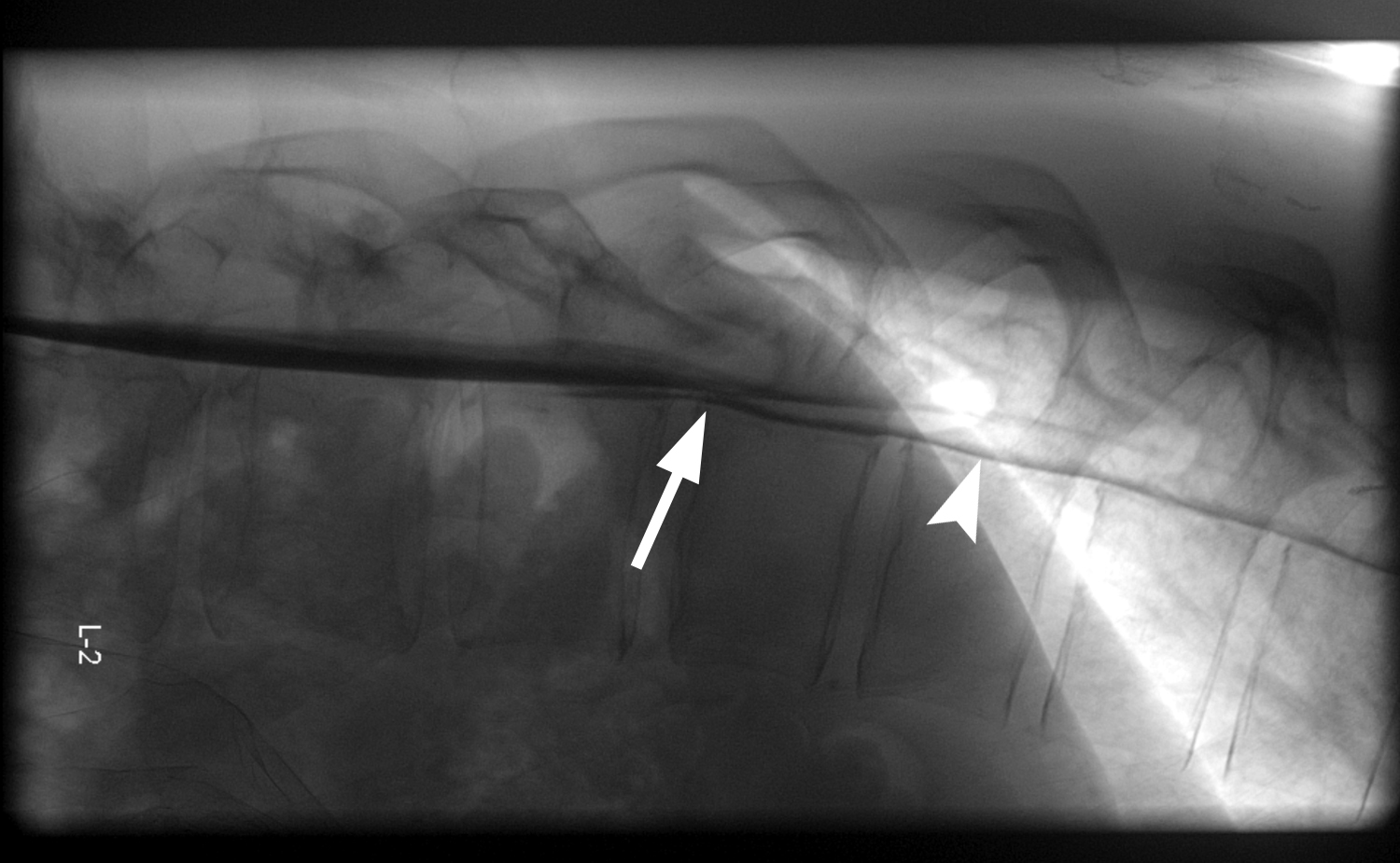
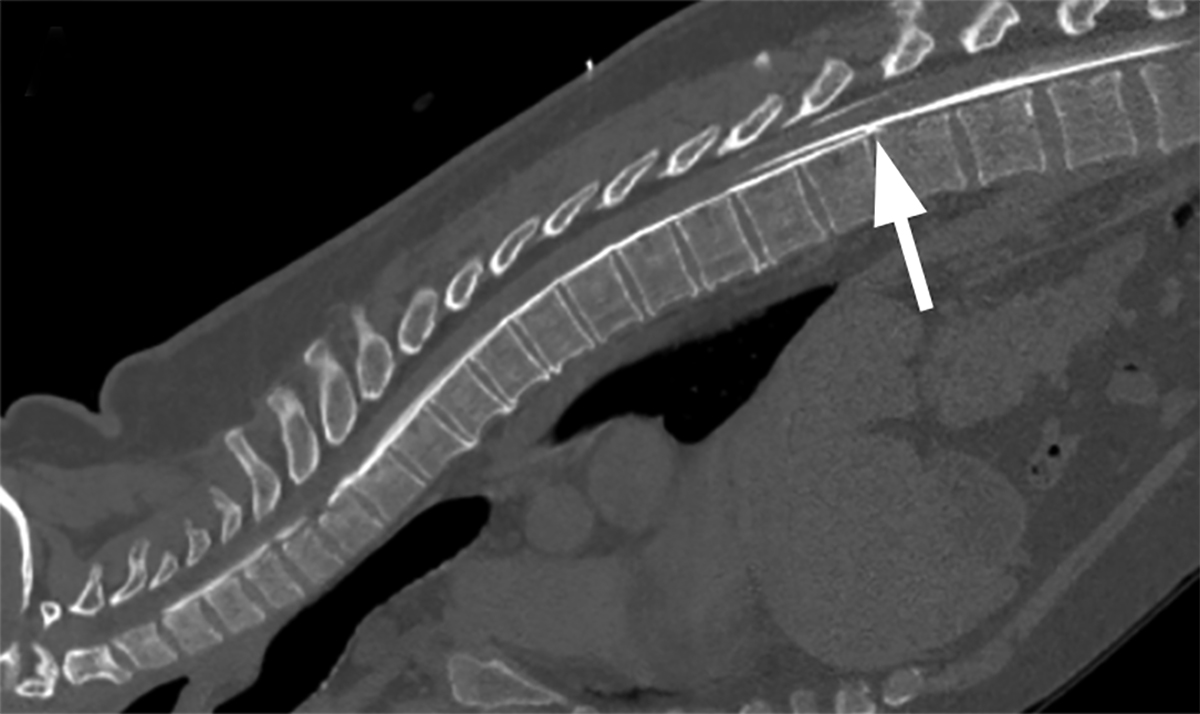
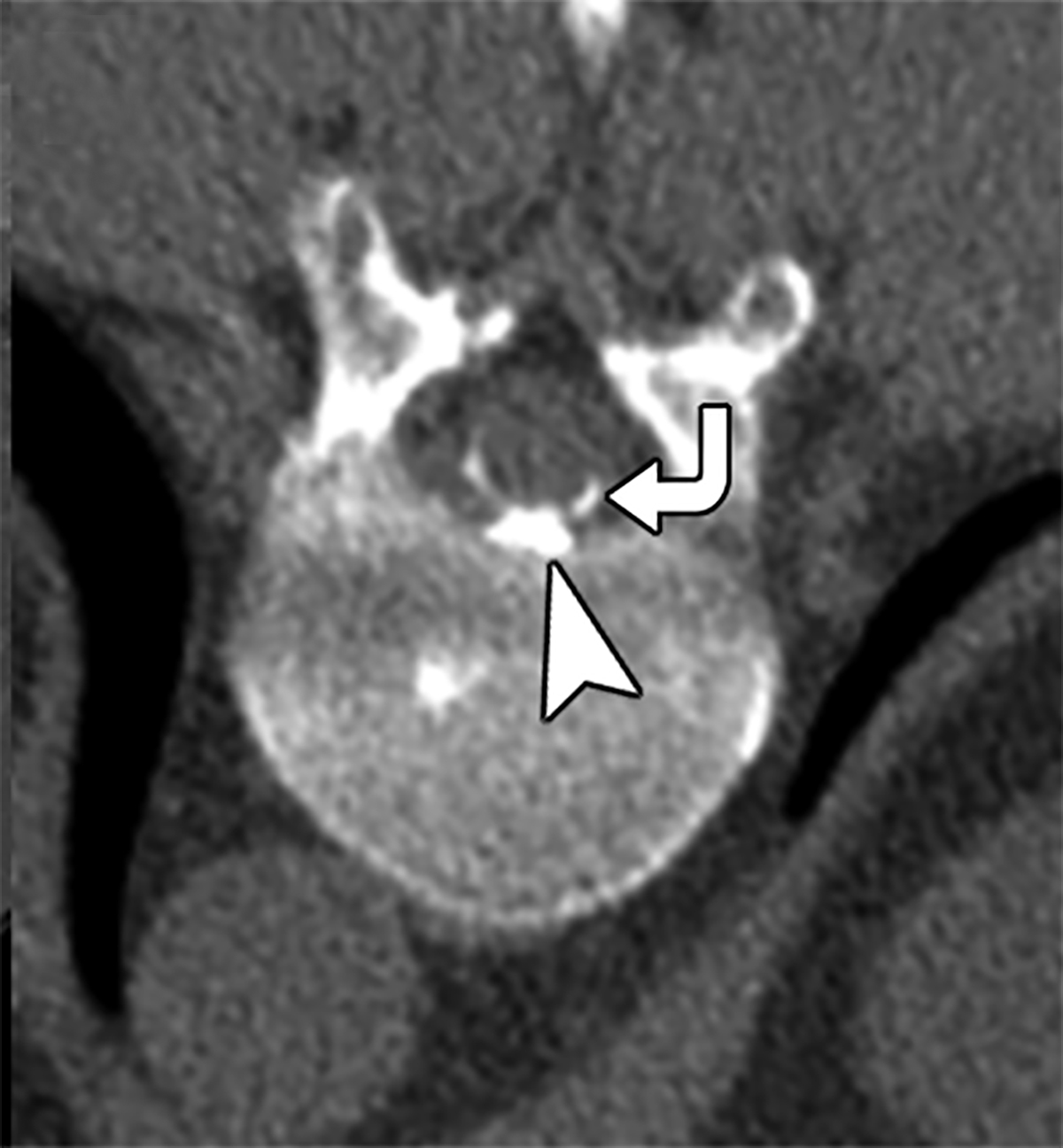
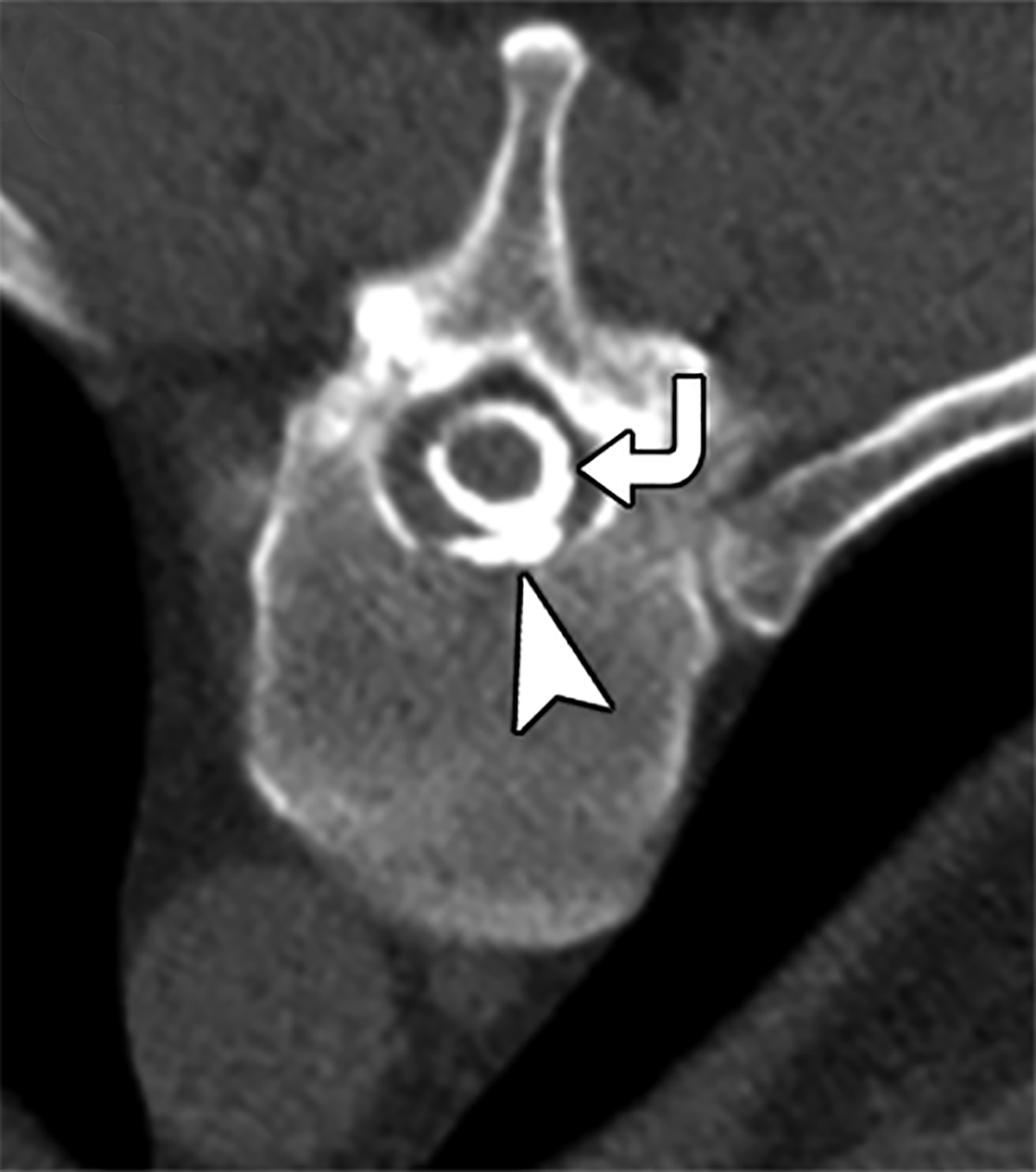
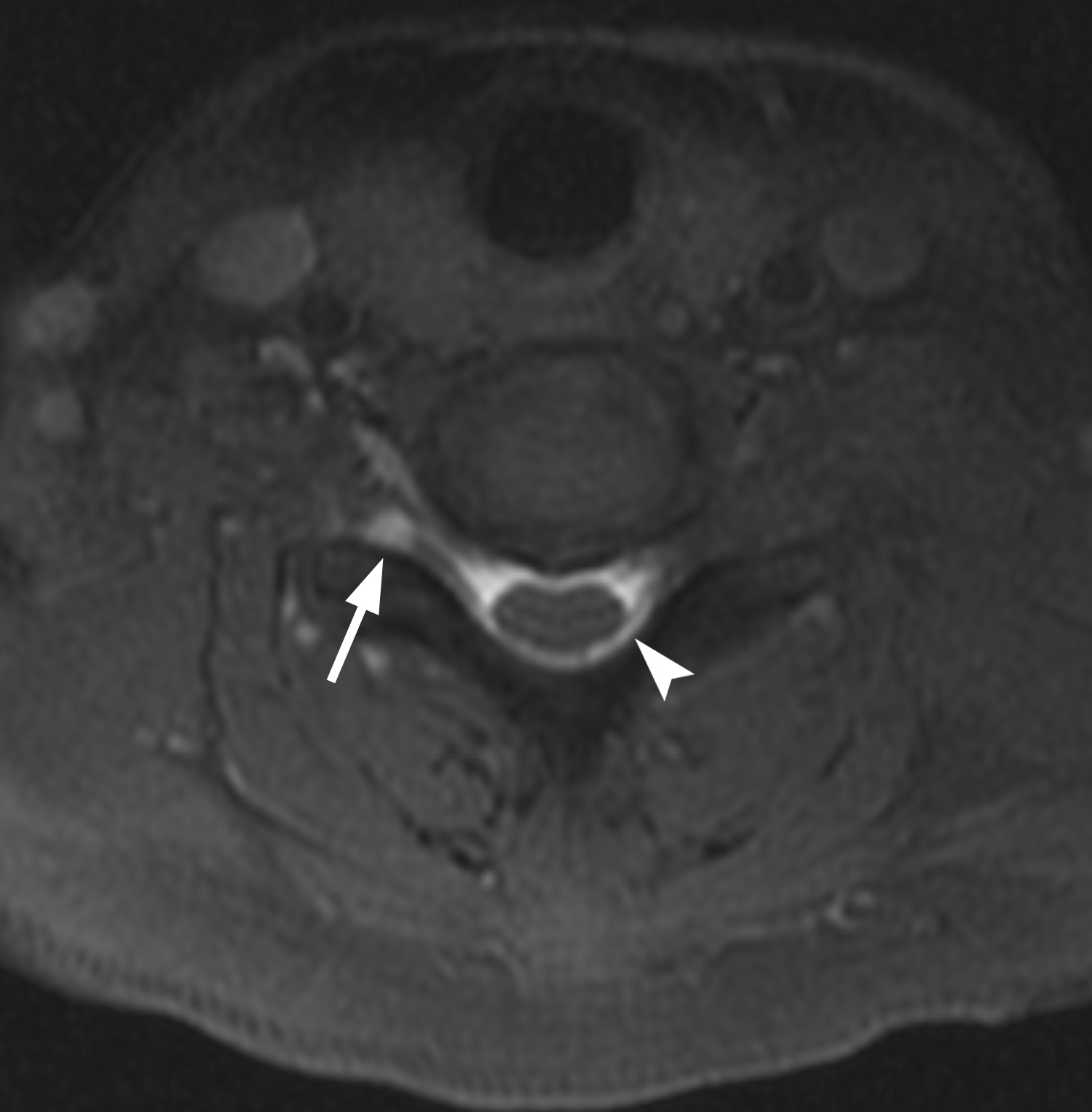
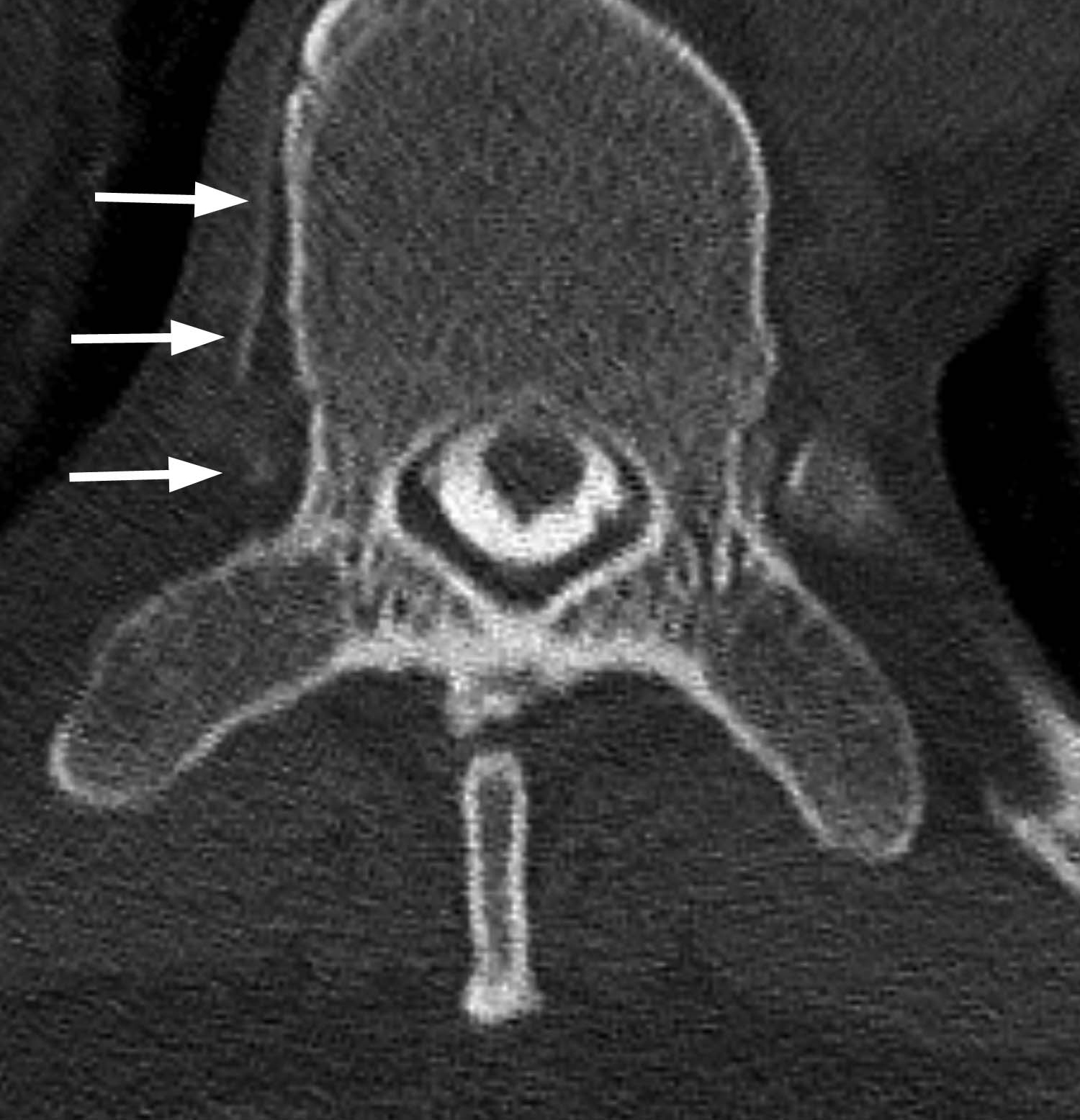
Spontaneous intracranial hypotension (SIH) is an unusual clinical entity in which patients often present with a spectrum of clinical signs and symptoms. Radiologists play a critical role not only in the diagnosis of this condition, but also in its treatment. Multiple imaging modalities may be used in defining this disease, and following the appropriate imaging algorithm is important to speed diagnosis and improve outcomes.
Etiology, pathophysiology and clinical features
Spontaneous intracranial hypotension is characterized by the classic triad of low cerebrospinal fluid (CSF) pressure, orthostatic headache, and brain “sag” with diffuse pachymeningeal enhancement.1 It has an estimated incidence of 5/100,000/year with a peak age of approximately 40 and a female predominance.2 Leakage of CSF into the epidural space through a defect in the thecal sac has been found to be the underlying cause in almost every case of SIH.3 Traumatic etiologies include motor vehicle collisions, sports related injuries, epidural catheterizations, surgery, and nerve root avulsions. Idiopathic or spontaneous etiologies include preexisting weakness of the dural sac secondary to connective tissue disorders or meningeal diverticula, calcified disc herniations or spiculated osteophytes, and CSF-venous fistulas.3-6
The headache associated with SIH is often orthostatic, occasionally triggered by Valsalva. Latency is typically minutes, but can be prolonged, typically bilateral, often holocephalic and may be throbbing in quality.6 Additional clinical symptoms include diplopia (typically related to traction on cranial nerve VI3-6 more than effects on cranial nerves III or IV), cochlear vestibular symptoms of tinnitus, sensorineural hearing loss and dizziness, nausea, gait disturbance, movement disorder, galactorrhea, and memory deficits. Occasionally, life-threatening CSF hypotension may result in stupor and coma.6-8
Brain imaging
Magnetic resonance imaging (MRI) with gadolinium is the imaging study of choice in the initial evaluation of a patient with suspected SIH. Approximately 80% of patients will present with diffuse non-nodular, pachymeningeal enhancement (Figure 1). The leptomeninges are not involved. Similar pachymeningeal enhancement can also be seen post-lumbar puncture, secondary to chronic shunting, recent craniotomy, subdural hematoma, meningitis, and with metastatic disease and lymphoma.9 The pachymeningeal enhancement is also seen in conjunction with “brain sag.”9, 10 This appearance, which is best demonstrated on sagittal MRI sequences, depicts downward migration of the cerebellar tonsils and brainstem, mimicking Arnold-Chiari type I malformation on MRI findings. There is often obliteration of the prepontine and perichiasmatic cisterns, with flattening of the pons and draping of the optic chiasm over the dorsum sella. The iter (or top of the cerebral aqueduct) typically descends below the incisural line, as opposed to Arnold-Chiari malformations where the iter typically remains unchanged in position (Figure 2).11 Other intracranial findings may include: subdural hygromas or hematomas, enlargement of the pituitary gland, ventricular collapse, engorged dural venous sinuses or plexus, and superficial siderosis.6,12-15
Spine imaging
The condition can be a self-limiting syndrome with spontaneous resolution. First-line treatments include conservative therapy such as oral hydration, pain medication, caffeine, and bed rest. Non-targeted large volume epidural blood patches typically performed in the upper lumbar region are often efficacious, but may need to be repeated.16 Second-line treatments include targeted blood patches or fibrin glue injections and open surgical repair. All second-line treatments require leak localization with spinal imaging, such as MRI, CT, myelogram, and nuclear medicine cisternography.
Indium-111 cisternography helps to confirm a CSF leak when the clinical diagnosis is uncertain. It has the advantage of prolonged, 24-48-hour monitoring which can be helpful in intermittent leaks. Disadvantages are its poor spatial resolution and its moderate sensitivity and specificity. Evidence of a leak on Indium-111 cisternography is demonstrated by para-thecal activity, renal uptake in < 4 hrs and delayed activity over the cerebral convexity (Figure 3).5
Patients with a suspected leak should undergo MRI of the entire spine. Imaging should include a blend of T1 and T2 pulse sequences in multiple planes. Findings on this exam will determine future diagnostic and therapeutic imaging studies. Luetmer et al have suggested an imaging paradigm for patients with SIH centered on the presence of an extradural fluid collection.17 Patients with a spinal extradural fluid collection (Figure 4) should have a follow-up dynamic CT myelogram. Those patients without an extradural fluid collection should proceed to conventional CT myelogram (including delayed imaging) to search for either a “slow” CSF leak which has not resulted in an extradural collection (Figure 5) or a CSF-venous fistula.3 At some institutions, digital subtraction myelography (DSM) is used to search for a CSF-venous fistula.3, 18-20
Dynamic myelography can be completed using fluoroscopy or CT. Dynamic fluoroscopic myelograms can be completed in a standard myelography suite. Lumbar puncture is completed with a 20 – 22-gauge spinal needle. Following measurement of an opening pressure, 10-17 cc of iodinated contrast is infused. Infusion should be completed with the patient in the Trendelenburg position. Contrast flow can be recorded using DSM imaging as it flows from caudal to cranial. The hallmark of a CSF leak is split or parallel contrast flow demonstrated by Hoxworth et al (Figure 6).21 CSF-venous fistulae may also be identified. Follow-up CT myelogram images are obtained to characterize the site and extent of CSF leak.
When performing dynamic CT myelography, patients are positioned prone in Trendelenburg position typically using a large foam wedge with the hips elevated above the craniocervical junction to ensure downward trajectory of contrast flow. Lumbar puncture can be completed in either the fluoroscopy room or simply under CT guidance. A 64 or 128 slice CT scanner is recommended.22 Preliminary spinal imaging is completed from the skull base to the sacrum prior to the infusion of contrast. These images may demonstrate a spiculated osteophyte or calcified disc extrusion which are occasionally implicated in CSF leaks, and can be hard to identify once intrathecal contrast has been adminstered.23 During infusion of diluted iodinated contrast material into the subarachnoid space, dynamic CT scanning is completed using up to 5 sequential alternating caudal-cranial and cranial-caudal series of the cervical, thoracic and lumbar spine. Raw data should be viewed during scanning in the CT area and reconstructed images viewed at a workstation. As in DSM identification of dural defects, high-flow leaks are classically identified by a “split” in the flow of contrast between intrathecal and active extradural flow (Figure 7).
Occasionally, conventional CT myelogram will not define a leak in patients with classic symptoms of SIH. These patients may be furthered imaged with intrathecal gadolinium MR myelogram (GdM, Figure 8)).24 GdM discovered leaks in 21% of patients with a reported negative conventional myelogram. Akbar et al reported no intrathecal complications of GdM in 24 cases.25
Recent reports are defining CSF to venous fistulas as another etiology of SIH.3 These fistulas are suggested on cisternography by early renal activity. Early renal activity may also be identified on CT and MRI imaging.18 DSM, CT myelography and GdM may suggest the fistula by depicting contrast in a para- spinal venous structure after the infusion of subarachnoid contrast (Figure 9). Pathophysiology in these cases is unclear. It may be related to a dilated epidural venous plexus and/or persistent/redeveloped arachnoid granulations.
Treatment
No clear algorithm exists for the treatment of SIH. Many retrospective studies exist, but high quality evidence is lacking. Treatment recommendations are largely empiric. Conservative measures should always be used as an initial treatment. However, conservative measures are unlikely to be successful in high-flow leaks. Epidural blood patches have demonstrated some utility in the management of CSF leaks. These include both non-targeted, high volume epidural infusions or targeted typically CT-guided blood patches at the site of a leak(s) or empirically at the site(s) of meningeal diverticulum.26 Repeated epidural patches may be required before long-term resolution of symptoms is achieved. Percutaneous therapies have variable success rates and modest recurrence rates. Ultimately, patients may proceed to surgical repair of the defect.
Conclusion
Spontaneous intracranial hypotension can be a challenging condition not only to diagnose, but also to treat. Radiologists should be aware of the myriad clinical presentations of this disease and the imaging pathway that can ultimately define the etiology and help direct the treatment of this condition.
References
- Schievink WI, Maya MM, Louy C, et al. Diagnostic criteria for spontaneous spinal CSF leaks and intracranial hypotension. AJNR Am J Neuroradiol. 2008;29(5):853-856.
- Mokri B. Spontaneous cerebrospinal fluid leaks: from intracranial hypotension to cerebrospinal fluid hypovolemia--evolution of a concept. Mayo Clin Proc. 1999;74(11):1113-1123.
- Kranz PG, Amrhein TJ, Schievink WI, et al. The “Hyperdense Paraspinal Vein” sign: A marker of CSF-venous fistula. AJNR Am J Neuroradiol. 2016;37(7):1379-1381.
- Kumar N, Diehn FE, Carr CM, et al. Spinal CSF venous fistula: A treatable etiology for CSF leaks in craniospinal hypovolemia. Neurology. 2016;86(24):2310-2312.
- Mokri B. Spontaneous intracranial hypotension. Curr Pain Headache Rep. 2001;5(3):284-291.
- Schievink WI. Spontaneous spinal cerebrospinal fluid leaks and intracranial hypotension. JAMA. 2006;295(19):2286-2296.
- Beck CE, Rizk NW, Kiger LT, et al. Intracranial hypotension presenting with severe encephalopathy. Case report. J Neurosurg. 1998;89(3):470-473.
- Pleasure SJ, Abosch A, Friedman J, et al. Spontaneous intracranial hypotension resulting in stupor caused by diencephalic compression. Neurology. 1998;50(6):1854-1857.
- Mokri B, Krueger BR, Miller GM. Meningeal gadolinium enhancement in low pressure headaches [abstract]. Ann Neurol. 1991; 30:294-295.
- Fishman RA, Dillon WP. Dural enhancement and cerebral displacement secondary to intracranial hypotension. Neurology. 1993;43(3):609-611.
- Sainani NI, Lawande MA, Pungavkar SA, et al. Spontaneous intracranial hypotension: a study of six cases with MR findings and literature review. Australas Radiol. 2006;50(5):419-423.
- Webb AJ, Flossmann E, Armstrong RJ. Superficial siderosis following spontaneous intracranial hypotension. Pract Neurol. 2015;15(5):382-384.
- Schievink WI, Maya MM, Moser FG, et al. Spectrum of subdural fluid collections in spontaneous intracranial hypotension. J Neurosurg. 2005;103(4):608-613.
- Baryshnik DB, Farb RI. Changes in the appearance of venous sinuses after treatment of disordered intracranial pressure. Neurology. 2004;62(8):1445-1446.
- Alvarez-Linera J, Escribano J, Benito-Leon J, et al. Pituitary enlargement in patients with intracranial hypotension syndrome. Neurology. 2000;55(12):1895-1897.
- Safa-Tisseront V, Thormann F, Malassine P, et al. Effectiveness of epidural blood patch in the management of post-dural puncture headache. Anesthesiology. 2001; 95:334-339.
- Luetmer PH, Schwartz KM, Eckel LJ, et al. When should I do dynamic CT myelography? Predicting fast spinal CSF leaks in patients with spontaneous intracranial hypotension. AJNR Am J Neuroradiol. 2012;33(4):690-694.
- Schievink WI, Moser FG, Maya MM. CSF-venous fistula in spontaneous intracranial hypotension. Neurology. 2014;83(5):472-473.
- Schievink WI, Moser FG, Maya MM, et al. Digital subtraction myelography for the identification of spontaneous spinal CSF-venous fistulas. J Neurosurg Spine. 2016;24(6):960-964.
- Kranz PG, Luetmer PH, Diehn FE, et al. Myelographic techniques for the detection of spinal CSF leaks in spontaneous intracranial hypotension. AJR Am J Roentgenol. 2016;206(1):8-19.
- Hoxworth JM, Patel AC, Bosch EP, et al. Localization of a rapid CSF leak with digital subtraction myelography. AJNR Am J Neuroradiol. 2009;30(3):516-519.
- Luetmer PH, Mokri B. Dynamic CT myelography: a technique for localizing high-flow spinal cerebrospinal fluid leaks. AJNR Am J Neuroradiol. 2003;24(8):1711-1714.
- Thielen KR, Sillery JC, Morris JM, et al. Ultrafast dynamic computed tomography myelography for the precise identification of high-flow cerebrospinal fluid leaks caused by spiculated spinal osteophytes. J Neurosurg Spine. 2015;22(3):324-331.
- Vanopdenbosch LJ, Dedeken P, Casselman JW, et al. MRI with intrathecal gadolinium to detect a CSF leak: a prospective open-label cohort study. J Neurol Neurosurg Psychiatry. 2011;82(4):456-458.
- Akbar JJ, Luetmer PH, Schwartz KM, et al. The role of MR myelography with intrathecal gadolinium in localization of spinal CSF leaks in patients with spontaneous intracranial hypotension. AJNR Am J Neuroradiol. 2012;33(3):535-540.
- Dillo W, Hollenhorst J, Brassel F, et al. Successful treatment of a spontaneous cervical cerebrospinal fluid leak with a CT guided epidural blood patch. J Neurol. 2002;249(2):224-225.
Citation
JT W, FE D.Spontaneous intracranial hypotension. Appl Radiol. 2018; (8):18-22.
August 1, 2018